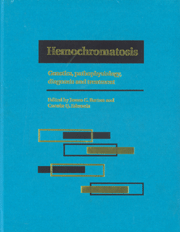Book contents
- Frontmatter
- Contents
- List of contributors
- Foreword
- Part I Introduction to hemochromatosis
- Part II Genetics of hemochromatosis
- Part III Metal absorption and metabolism in hemochromatosis
- Part IV Diagnostic techniques for iron overload
- Part V Complications of iron overload
- Part VI Therapy of hemochromatosis and iron overload
- Part VII Infections and immunity in hemochromatosis
- Part VIII Hemochromatosis heterozygotes
- Part IX Relationship of hemochromatosis to other disorders
- Part X Animal models of hemochromatosis and iron overload
- 47 β2-microglobulin-deficient mice as a model for hemochromatosis
- 48 Animal models of iron overload based on excess exogenous iron
- 49 Naturally occurring iron overload in animals
- Part XI Screening for hemochromatosis
- Part XII Hemochromatosis: societal and ethical issues
- Part XIII Final issues
- Index
47 - β2-microglobulin-deficient mice as a model for hemochromatosis
from Part X - Animal models of hemochromatosis and iron overload
Published online by Cambridge University Press: 05 August 2011
- Frontmatter
- Contents
- List of contributors
- Foreword
- Part I Introduction to hemochromatosis
- Part II Genetics of hemochromatosis
- Part III Metal absorption and metabolism in hemochromatosis
- Part IV Diagnostic techniques for iron overload
- Part V Complications of iron overload
- Part VI Therapy of hemochromatosis and iron overload
- Part VII Infections and immunity in hemochromatosis
- Part VIII Hemochromatosis heterozygotes
- Part IX Relationship of hemochromatosis to other disorders
- Part X Animal models of hemochromatosis and iron overload
- 47 β2-microglobulin-deficient mice as a model for hemochromatosis
- 48 Animal models of iron overload based on excess exogenous iron
- 49 Naturally occurring iron overload in animals
- Part XI Screening for hemochromatosis
- Part XII Hemochromatosis: societal and ethical issues
- Part XIII Final issues
- Index
Summary
Introduction
The roles of specific components of iron metabolism associated with gross iron maldistribution have been evaluated by identifying mutations in genes related to human diseases and by generating and phenotyping genetically altered mice. A list of new genes involved in iron metabolism that have been identified, cloned, and characterized recently is presented in Table 47.
Absorption of low molecular weight iron
Although iron is an abundant element, its availability is reduced because the oxidized form of the metal, iron (III), is extremely insoluble at neutral pH. Thus, complex mechanisms for its acquisition, utilization, and preservation have evolved in even the most primitive organisms. The process of intestinal iron absorption in mammals occurs in phases (Fig. 47.1). In the initial uptake phase, iron is transported into the intestinal epithelial cell. Ferric iron in the lumen of the gut is reduced to ferrous iron by a ferric reductase. Next, the ferrous iron product is transported into the cell by a ferrous transporter, recently identified as DCT1/Nramp2, which is mutated in microcytic anemia (mk) mice. Mucosal uptake is influenced by many intraluminal factors, including the chemical state of the iron in the test dose (ferric or ferrous, heme or non-heme), the amount of iron, the composition of the test dose, gastric and intestinal secretions, and the state of the brush border of the mucosal cells.
- Type
- Chapter
- Information
- HemochromatosisGenetics, Pathophysiology, Diagnosis and Treatment, pp. 487 - 493Publisher: Cambridge University PressPrint publication year: 2000
- 1
- Cited by



